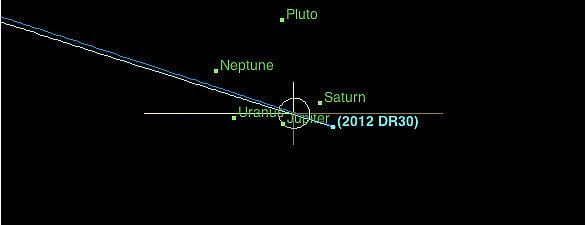Discovered by Spacewatch MPC designation 2012 DR30 Observation arc 14.72 yr (5,375 days) Absolute magnitude 7.1 Apparent magnitude 19.9 | Discovery date 31 March 2009 Alternative names 2009 FW54 Discovered 31 March 2009 Asteroid group Centaur Discoverer Spacewatch | |
 | ||
Minor planet category Distant · TNO
centaur
Damocloid Discovery site Kitt Peak National Observatory Similar 2013 BL76, 2007 TG422, 2008 ST291 | ||
2012 DR30 also provisionally designated 2009 FW54 is a trans-Neptunian centaur from the scattered disk/Inner Oort cloud, approximately 185–200 kilometers in diameter.
Using an epoch of February 2017, it has the second-largest heliocentric semi-major axis of a minor planet not detected out-gassing like a comet. (2014 FE72 has a larger heliocentric semi-major axis.) 2012 DR30 does have a barycentric semi-major axis of 1032 AU. The epoch of July 2018 will be when 2012 DR30 will have its largest heliocentric semi-major axis of 1644 AU.
2012 DR30 passed 5.7 AU from Saturn in February 2009 and came to perihelion in March 2011 at a distance of 14.5 AU from the Sun (inside the orbit of Uranus). In 2017, it will move from 17.3 AU to 18.2 AU from the Sun. It comes to opposition in late March. With an absolute magnitude (H) of 7.1, the object has an estimated diameter of 185 km.
With an observation arc of 14.7 years, it has a well constrained orbit. It will not be 50 AU from the Sun until 2047. After leaving the planetary region of the Solar System, 2012 DR30 will have a barycentric aphelion of 2049 AU with an orbital period of 33100 years.
In a 10 million year integration of the orbit, the nominal (best-fit) orbit and both 3-sigma clones remain outside 12.2 AU (qmin) from the Sun.
Summary of barycentric orbital parameters are:
